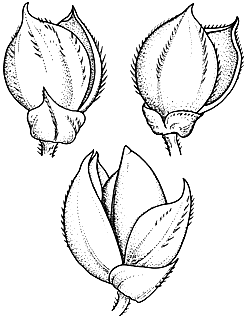Common name: Siberian Millet
Echinochloa frumentacea Link APNI* 
Description: Annual to 1 m high, stout at least towards base.
Leaves with ligule absent; blade 3–20 mm wide.
Panicle to c. 18 cm long, erect to slightly drooping at maturity. Spikelets mostly 2 or 3 together on scabrous pedicels, 3–3.5 mm long, acute to obtuse, pale-coloured; florets 2 or 3, sometimes 2 fertile florets present as well as a one sterile. Lower glume 30–50% of spikelet length, shortly acute, mostly 3-nerved; upper slightly shorter than spikelet, shortly acute, 5–7-nerved. Lower lemma equal to spikelet, 7-nerved. Fertile lemma ovate to elliptic, 2.5–3 mm long, with a short, herbaceous tip, smooth, shining, obscurely 5-nerved. Lower palea shorter and narrower than lower lemma. Upper palea similar to upper lemma. Grain ovate, c. 2.1 mm long, turgid, whitish.
Flowering: summer.
Distribution and occurrence: Cultivated for forage and grain, also sometimes as a soil stabilizer. An escape from cultivation. Originated in India, now widely cultivated.
NSW subdivisions: *NC, *CC, *NT, *NWS, *SWS, *NWP, *SWP, *NFWP
Other Australian states: *Qld *Vic. *W.A.
Text by S. W. L. Jacobs & T. A. James
Taxon concept: Flora of NSW 4 (1993)
APNI* Provides a link to the Australian Plant Name Index (hosted by the Australian National Botanic Gardens) for comprehensive bibliographic data
***The AVH map option provides a detailed interactive Australia wide distribution map drawn from collections held by all major Australian herbaria participating in the Australian Virtual Herbarium project.
|


